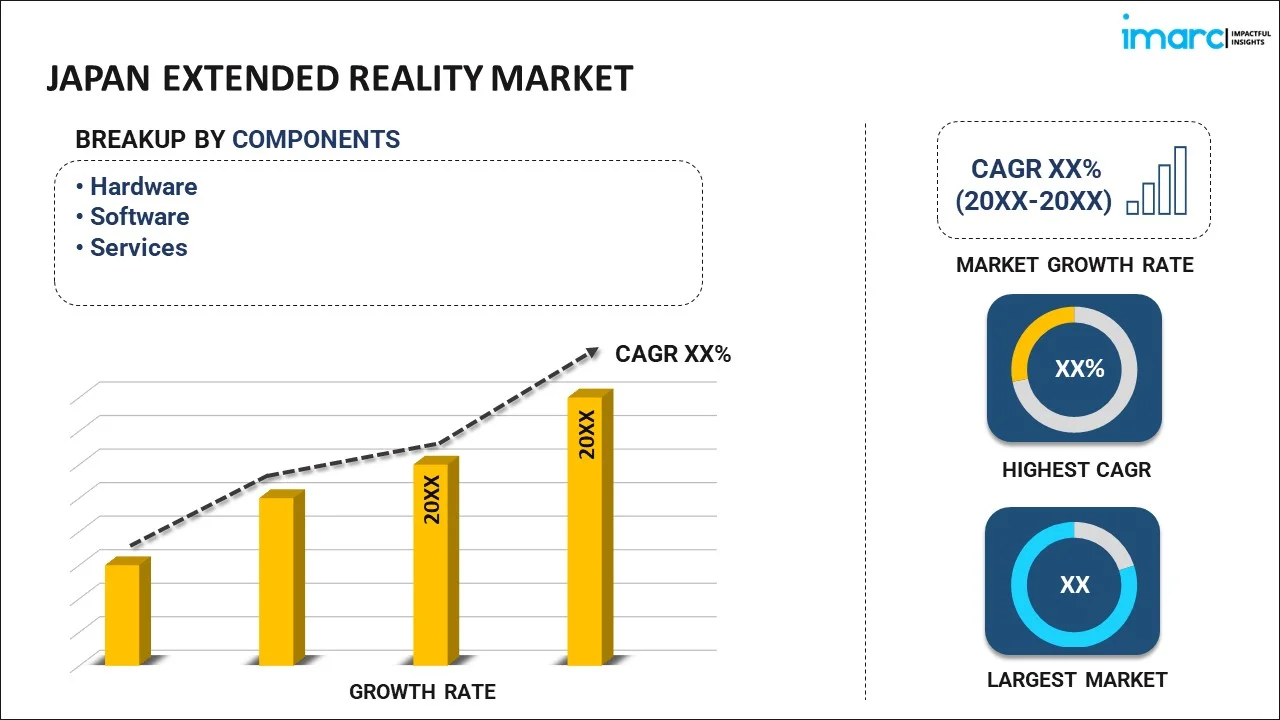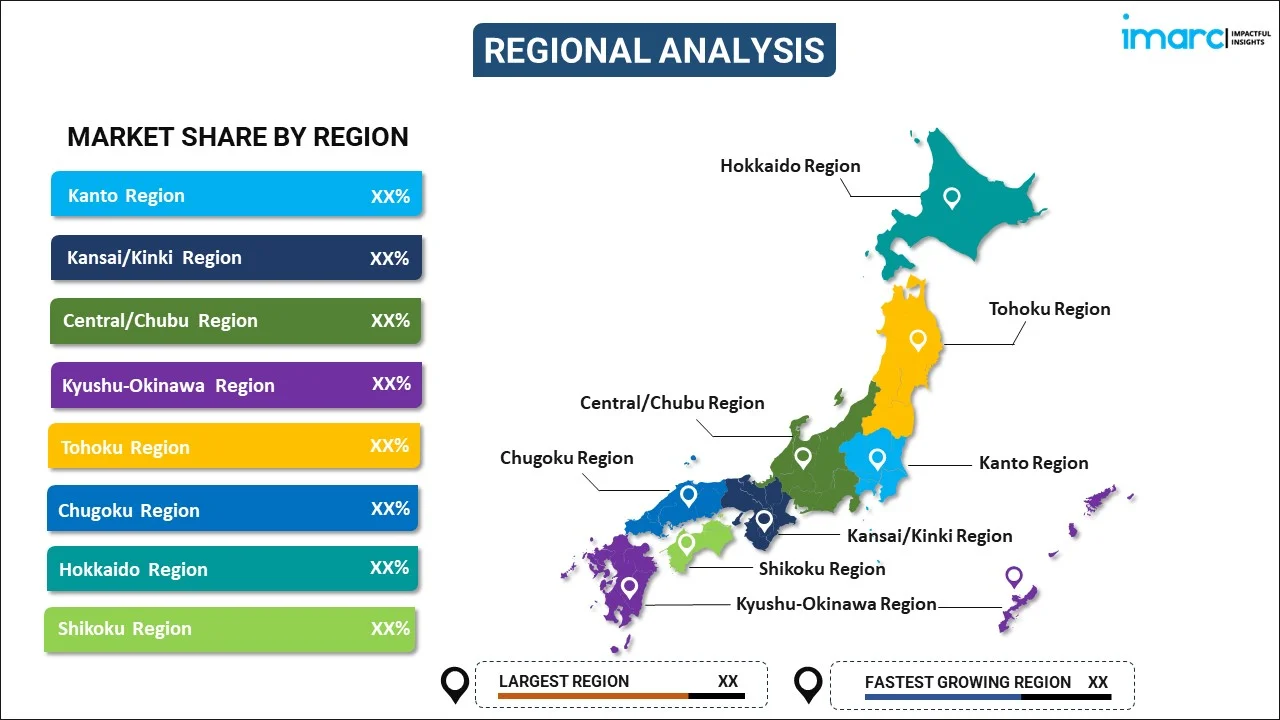
Japan Extended Reality Market Report by Component (Hardware, Software, Services), Type (Consumer Engagement, Business Engagement), Organization Size (Small and Medium-sized Enterprises, Large Enterprises), Application (Virtual Reality (VR), Augmented Reality (AR), Mixed Reality (MR)), End User Industry (Education, Retail, Industrial and Manufacturing, Healthcare, Media and Entertainment, and Others), and Region 2026-2034
Market Overview:
Japan extended reality market size reached USD 9.8 Billion in 2025. Looking forward, IMARC Group expects the market to reach USD 73.1 Billion by 2034, exhibiting a growth rate (CAGR) of 24.95% during 2026-2034. The market is experiencing growth due to the growing trend of utilizing this technology for the preservation of cultural heritage and the creation of virtual museums.
|
Report Attribute
|
Key Statistics
|
|---|---|
|
Base Year
|
2025 |
|
Forecast Years
|
2026-2034
|
|
Historical Years
|
2020-2025
|
| Market Size in 2025 | USD 9.8 Billion |
| Market Forecast in 2034 | USD 73.1 Billion |
| Market Growth Rate (2026-2034) | 24.95% |
Extended reality (XR) is a comprehensive term encompassing a range of immersive technologies, including virtual reality (VR), augmented reality (AR), and mixed reality (MR). XR merges the digital and physical realms to create interactive and engrossing user experiences. This technology allows users to interact with computer-generated environments and objects, whether by fully immersing themselves in virtual worlds or by overlaying digital elements onto the real world. XR holds transformative potential across various sectors. In the realm of gaming and entertainment, it delivers lifelike and immersive experiences, elevating the quality of storytelling and gameplay. In education and training, XR facilitates interactive simulations and immersive learning environments. In healthcare, it plays a role in medical training, surgical planning, and patient care. Furthermore, XR has applications in architecture, engineering, and design, empowering stakeholders to visualize and engage with virtual models of structures and designs.
Japan Extended Reality Market Trends:
The extended reality market in Japan is experiencing remarkable growth driven by several key factors. The country has a rich technological landscape and a strong culture of innovation, making it well-positioned to embrace XR technologies. Additionally, in the educational sector, extended reality is gaining prominence for its ability to create engaging and interactive learning environments, aligning with Japan's commitment to innovative educational approaches. Furthermore, Japan's healthcare industry is leveraging extended reality for medical training, surgical planning, and improving patient care through innovative applications. In architecture and engineering, XR aids in visualizing complex designs and structures, enhancing the efficiency of planning and development processes. Japan's historical and cultural significance also plays a role, as extended reality technologies are being used to preserve and present cultural heritage in virtual museums and exhibits. The government's support for XR research and development, along with collaborations between local tech companies and international XR leaders, is contributing to the market's expansion. With its blend of technological prowess, cultural appreciation, and commitment to innovation, Japan is poised to make significant strides in the extended reality market over the forecasted period.
Japan Extended Reality Market Segmentation:
IMARC Group provides an analysis of the key trends in each segment of the market, along with forecasts at the country level for 2026-2034. Our report has categorized the market based on component, type, organization size, application, and end use industry.
Component Insights:

- Hardware
- Software
- Services
The report has provided a detailed breakup and analysis of the market based on the component. This includes hardware, software, and services.
Type Insights:
- Consumer Engagement
- Business Engagement
A detailed breakup and analysis of the market based on the type have also been provided in the report. This includes consumer engagement and business engagement.
Organization Size Insights:
- Small and Medium-sized Enterprises
- Large Enterprises
The report has provided a detailed breakup and analysis of the market based on the organization size. This includes small and medium-sized enterprises and large enterprises.
Application Insights:
- Virtual Reality (VR)
- Augmented Reality (AR)
- Mixed Reality (MR)
A detailed breakup and analysis of the market based on the application have also been provided in the report. This includes virtual reality (VR), augmented reality (AR), and mixed reality (MR).
End Use Industry Insights:
- Education
- Retail
- Industrial and Manufacturing
- Healthcare
- Media and Entertainment
- Others
The report has provided a detailed breakup and analysis of the market based on the end use industry. This includes education, retail, industrial and manufacturing, healthcare, media and entertainment, and others.
Regional Insights:

- Kanto Region
- Kansai/Kinki Region
- Central/ Chubu Region
- Kyushu-Okinawa Region
- Tohoku Region
- Chugoku Region
- Hokkaido Region
- Shikoku Region
The report has also provided a comprehensive analysis of all the major regional markets, which include Kanto Region, Kansai/Kinki Region, Central/ Chubu Region, Kyushu-Okinawa Region, Tohoku Region, Chugoku Region, Hokkaido Region, and Shikoku Region.
Competitive Landscape:
The market research report has also provided a comprehensive analysis of the competitive landscape. Competitive analysis such as market structure, key player positioning, top winning strategies, competitive dashboard, and company evaluation quadrant has been covered in the report. Also, detailed profiles of all major companies have been provided.
Japan Extended Reality Market News:
- May 2025: KU Leuven released the ‘Erasmus Mundus Master of Science in Imaging and Light in Extended Reality’ course in Japan. The aim was to train students in cutting-edge technologies, approaches, and hands-on implementations with two objectives: enhancing the employment opportunities for graduates and addressing the demands of industry and society. Graduates would possess skills in extended, augmented, mixed, and virtual reality.
- May 2025: Mawari unveiled vTubeXR, the first extended reality platform for fan engagement in Japan, which allowed immersive 3D interactions between VTubers and fans. vTubeXR introduced unmatched personalization in fan interactions with beloved VTubers through a completely immersive 3D meet & greet experience.
- March 2025: SoftBank and Ericsson made an agreement to work together on next-generation telecommunications technology. They aimed to achieve progress in various essential domains, such as extended reality and 6G, by 2030. They committed to assessing the market readiness of cloud RAN implementation, which included service management and orchestration (SMO) alongside RAN automation applications, as well as the integration of artificial intelligence (AI) technology.
- February 2025: The Dig Shibuya digital art festival was set to take place from February 8 to 11, featuring tech-enhanced art shows and events throughout Tokyo’s most fashionable area, encompassing Miyashita Park, Shibuya Parco, and Shibuya Sakura Stage. The Shibuya Welfare Center would serve as a unique center for the festival, featuring light projections and motion-capture technology in ‘Around the Corner,’ an interactive showcase of socio-cultural, exploratory designs by the tech-oriented artist group extended reality art (XRT).
- February 2025: Digital Entertainment City Namba, an extended reality initiative, was introduced in Osaka with AI guides incorporated throughout the city. These AI-powered characters could perform tasks from tourism assistance to customer support, fostering natural, human-like interactions that surpassed language obstacles.
- August 2024: The Nihon XR Center in Tokyo, Japan, unveiled a significant extended reality project being developed for the Tokyo Dome Corporation. It would initially adopt extended reality games, attractions, and solutions as its core business and training offerings for larger companies.
Japan Extended Reality Market Report Coverage:
| Report Features | Details |
|---|---|
| Base Year of the Analysis | 2025 |
| Historical Period | 2020-2025 |
| Forecast Period | 2026-2034 |
| Units | Billion USD |
| Scope of the Report | Exploration of Historical and Forecast Trends, Industry Catalysts and Challenges, Segment-Wise Historical and Predictive Market Assessment:
|
| Components Covered | Hardware, Software, Services |
| Types Covered | Consumer Engagement, Business Engagement |
| Organization Sizes Covered | Small and Medium-sized Enterprises, Large Enterprises |
| Applications Covered | Virtual Reality (VR), Augmented Reality (AR), Mixed Reality (MR) |
| End Users Industry Covered | Education, Retail, Industrial and Manufacturing, Healthcare, Media and Entertainment, Others |
| Regions Covered | Kanto Region, Kansai/Kinki Region, Central/ Chubu Region, Kyushu-Okinawa Region, Tohoku Region, Chugoku Region, Hokkaido Region, Shikoku Region |
| Customization Scope | 10% Free Customization |
| Post-Sale Analyst Support | 10-12 Weeks |
| Delivery Format | PDF and Excel through Email (We can also provide the editable version of the report in PPT/Word format on special request) |
Key Benefits for Stakeholders:
- IMARC’s industry report offers a comprehensive quantitative analysis of various market segments, historical and current market trends, market forecasts, and dynamics of the Japan extended reality market from 2020-2034.
- The research report provides the latest information on the market drivers, challenges, and opportunities in the Japan extended reality market.
- Porter's five forces analysis assist stakeholders in assessing the impact of new entrants, competitive rivalry, supplier power, buyer power, and the threat of substitution. It helps stakeholders to analyze the level of competition within the Japan extended reality industry and its attractiveness.
- Competitive landscape allows stakeholders to understand their competitive environment and provides an insight into the current positions of key players in the market.
Key Questions Answered in This Report
The extended reality market in Japan was valued at USD 9.8 Billion in 2025.
The Japan extended reality market is projected to exhibit a CAGR of 24.95% during 2026-2034, reaching a value of USD 73.1 Billion by 2034.
In retail and real estate, businesses are using extended reality to create interactive shopping and property viewing experiences. Japan’s focus on innovation, coupled with its strong tech infrastructure and interest in automation, is further supporting extended reality development. Additionally, rising interest in wearable devices and immersive content, along with the integration of 5G technology, is enabling smoother, high-quality extended reality applications.
Need more help?
- Speak to our experienced analysts for insights on the current market scenarios.
- Include additional segments and countries to customize the report as per your requirement.
- Gain an unparalleled competitive advantage in your domain by understanding how to utilize the report and positively impacting your operations and revenue.
- For further assistance, please connect with our analysts.
 Request Customization
Request Customization
 Speak to an Analyst
Speak to an Analyst
 Request Brochure
Request Brochure
 Inquire Before Buying
Inquire Before Buying




.webp)




.webp)












